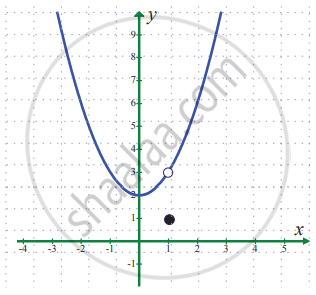Advertisements
Advertisements
प्रश्न
Evaluate the following limits:
`lim_(x -> oo) x [3^(1/x) + 1 - cos(1/x) - "e"^(1/x)]`
उत्तर
We know `lim_(x -> 0) ("e"^x - 1)/x` = 1
`lim_(x -> 0) ("a"^x - 1)/x` = log a
`lim_(x -> 0) (1 - cosx)/x` = 0
`lim_(x -> oo) [3^(1/x) + 1 - cos(1/x) - "e"^(1/x)] = lim_(x -> oo) [(3^(1/x) + 1 - cos(1/x) - "e"^(1/x))/(1/x)]`
= `lim_(x -> oo) [(3^(1/x) - 1 + 1 - "e"^(1/x))/(1/x) + (1 - cos(1/x))/(1/x)]`
= `lim_(x -> oo) [((3^(1/x) - 1) - ("e"^(1/x) - 1))/(1/x) + (1 - cos(1/x))/(1/x)]`
= `lim_(x > 0)[(3^(1/x) - 1)/(1/x) - ("e"^(1/x) - 1)/(1/x) + (1 -cos(1/x))/(1/x)]`
Put y = `1/x`
When x = `oo`
⇒ y = `1/oo` = 0
`lim_(x -> oo) x [3^(1/x) + 1 - cos(1/x) - "e"^(1/x)] = lim_(y - 0) [(3y - 1)/y - ("e"^y - 1)/y + (1 - cosy)/y]`
= `(lim_(y -> 0) (3^y - 1)/y) -(lim_(y -> 0) ("e"^y - 1)/y) + (lim_(y -> 0) (1 - cosy)/y)`
= `log 3 - 1 + 0`
`lim_(x -> oo) x [3^(1/x) + 1 - cos(1/x) - "e"^(1/x)] = (log 3) - 1`
APPEARS IN
संबंधित प्रश्न
Evaluate the following limit :
`lim_(x -> 7)[((root(3)(x) - root(3)(7))(root(3)(x) + root(3)(7)))/(x - 7)]`
Evaluate the following limit :
`lim_(x -> 0)[((1 - x)^8 - 1)/((1 - x)^2 - 1)]`
Evaluate the following limit :
`lim_(x -> 0)[(root(3)(1 + x) - sqrt(1 + x))/x]`
In the following example, given ∈ > 0, find a δ > 0 such that whenever, |x – a| < δ, we must have |f(x) – l| < ∈.
`lim_(x -> 2)(2x + 3)` = 7
In the following example, given ∈ > 0, find a δ > 0 such that whenever, |x – a| < δ, we must have |f(x) – l| < ∈.
`lim_(x -> 1) (x^2 + x + 1)` = 3
In problems 1 – 6, using the table estimate the value of the limit.
`lim_(x -> 2) (x - 2)/(x^2 - x - 2)`
| x | 1.9 | 1.99 | 1.999 | 2.001 | 2.01 | 2.1 |
| f(x) | 0.344820 | 0.33444 | 0.33344 | 0.333222 | 0.33222 | 0.332258 |
In problems 1 – 6, using the table estimate the value of the limit
`lim_(x -> 0) sin x/x`
| x | – 0.1 | – 0.01 | – 0.001 | 0.001 | 0.01 | 0.1 |
| f(x) | 0.99833 | 0.99998 | 0.99999 | 0.99999 | 0.99998 | 0.99833 |
In exercise problems 7 – 15, use the graph to find the limits (if it exists). If the limit does not exist, explain why?
`lim_(x -> 1) f(x)` where `f(x) = {{:(x^2 + 2",", x ≠ 1),(1",", x = 1):}`
Evaluate the following limits:
`lim_(x -> 0) (sqrt(x^2 + 1) - 1)/(sqrt(x^2 + 16) - 4)`
Evaluate the following limits:
`lim_(x -> 1) (root(3)(7 + x^3) - sqrt(3 + x^2))/(x - 1)`
Evaluate the following limits:
`lim_(x -> 2) (2 - sqrt(x + 2))/(root(3)(2) - root(3)(4 - x))`
Find the left and right limits of f(x) = tan x at x = `pi/2`
Show that `lim_("n" -> oo) (1^2 + 2^2 + ... + (3"n")^2)/((1 + 2 + ... + 5"n")(2"n" + 3)) = 9/25`
Evaluate the following limits:
`lim_(x -> 0) (sinalphax)/(sinbetax)`
Evaluate the following limits:
`lim_(x -> 0) (1 - cos^2x)/(x sin2x)`
Evaluate the following limits:
`lim_(x -> oo) ((x^2 - 2x + 1)/(x^2 -4x + 2))^x`
`lim_(x -> 0) ((2 + x)^5 - 2)/((2 + x)^3 - 2)` = ______.
`lim_(x -> 5) |x - 5|/(x - 5)` = ______.
The value of `lim_(x rightarrow 0) (sqrt((1 + x^2)) - sqrt(1 - x^2))/x^2` is ______.
